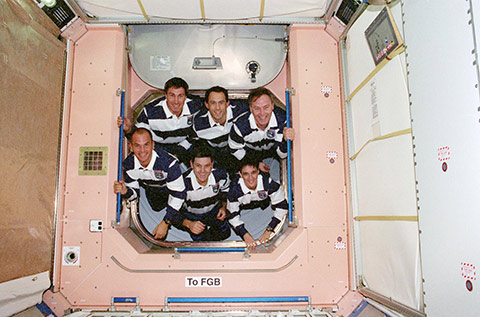ISS 20th Logo patch.
Nov. 5, 2019
On Oct. 31, 2000, veteran NASA astronaut William “Shep” Shepherd left Earth on a journey to the International Space Station with the distinction of becoming its first commander, beginning almost two decades of continuous human presence in low-Earth orbit.
The Expedition One crew members aboard the International Space Station
At the time, the space station was a small orbiting complex of just three modules, not the sprawling research complex that today is as large as a five-bedroom home with a gym, two bathrooms and a 360-degree bay window looking at Earth below.
Before Shepherd, who lifted off from the Baikonur Cosmodrome on the Soyuz TM-31 spacecraft, and cosmonauts Yuri Gidzenko and Sergei Krikalev of Roscosmos opened the hatches to their new home two days later, only six visiting crewmembers had been inside after connecting the first two modules, one a U.S.-funded, Russian built and launched power and control module called Zarya, and the other the first U.S. connecting node named Unity.
The STS-88 crew members pose for the traditional inflight crew portrait
For Shepherd and the two cosmonauts who made up Expedition 1, entrance into the early station marked the beginning of an unprecedented era of peaceful cooperation in space, paving the way for hundreds of residents and visitors from countries around the world who conduct science in the name ofbenefitting humankind and furthering space exploration for NASA's Artemis program to land the first woman and next man on the Moon in preparation to go on to Mars.
Highlights of space station statistics include:
- The primary pieces of the space station were delivered on 42 assembly flights: 37 on the U.S. space shuttles and five on Russian Proton/Soyuz rockets. Elements were constructed independent of one another around the globe and assembled for the first time in space.
- The space station took 11 years to fully construct. Its current configuration measures 357 feet end to end with a mass of nearly 1 million pounds. Elements of space station are continually added and reconfigured.
- There have been 221 spacewalks for space station assembly, maintenance and upgrades.
- It took a collaborative effort by 15 nations to construct the space station in orbit, and that collaboration continues today. The principal space agencies are the United States’ NASA, Russia’s Roscomos, ESA (European Space Agency), Japan Aerospace Exploration Agency (JAXA) and the Canadian Space Agency (CSA).
- 239 individuals from 19 countries have visited or enjoyed extended stays on the space station.
- Peggy Whitson holds the record for cumulative days in space by a NASA astronaut at 665 days. She also holds the record for longest duration by a woman astronaut at 289 days.
- Christina Koch is set to break that record December, 2019.
- Scott Kelly holds the record for longest single spaceflight by a NASA astronaut at 342 days where he participated in the One-Year Mission with Russian cosmonaut Mikhail Kornienko.
- More than 2,700 investigations have been conducted on the space station from 108 different countries.
Astronaut Scott Tingle is pictured during a robotics maintenance spacewalk
Around 250 scientific investigations are conducted on the station at any given time, and an expedition astronaut’s usual stay aboard the orbiting laboratory is six-months. The space station serves as a test bed for innovative technologies like recycling waste plastic and carbon dioxide filtration that are critical for long-duration missions on the lunar surface in the Artemis program.
Crew member safety also is important for lunar missions, so data collected from bone scans and eye exams helps inform what happens to the human body in space.
State-of-the-art facilities on board station help NASA increase understanding of what it will take to expand human exploration beyond low-Earth orbit, and microgravity research into protein crystal growth and fiber-optic cables offers scalable commercial opportunities and benefits for humanity.
Astronaut Anne McClain installs of the Thermal Amine Scrubber in the Destiny module
The space station has expanded these efforts to open for more commercial activities with the goal of building a self-sustaining commercial economy in low-Earth orbit where NASA can be one of many commercial and international customers.
The 19th anniversary of Shepherd’s launch to the station kicks off NASA’s year of recognition that will continue through the 20th anniversary of his Expedition 1 launch, and the beginning of a continuous human presence on the International Space Station that continues today. Throughout the year, NASA will make new content available, such as archival footage, feature videos, STEM (science, technology, engineering and math) products, special events, and unique logos for the general public. The content will recognize not only the anniversary, but also demonstrate how the research conducted and lessons learned on the space station will serve as a launching pad for future lunar and Mars exploration under the banner of NASA’s Artemis program and the continued international and commercial cooperation that will continue to return benefits for all humankind.
The Soyuz rocket lifts off with the Expedition One crew on Oct.31, 2000
Engage with the International Space Station on social media:
#SpaceStation20th
http://www.facebook.com/ISS
https://twitter.com/Space_Station
https://twitter.com/ISS_Research
http://instagram.com/iss
Spot the Station in the Night Sky: https://spotthestation.nasa.gov/
Humans in Space: https://www.nasa.gov/topics/humans-in-space
International Space Station (ISS): https://www.nasa.gov/mission_pages/station/main/index.html
Images (mentioned), Text, Credits: NASA/Mark Garcia.
Best regards, Orbiter.ch







